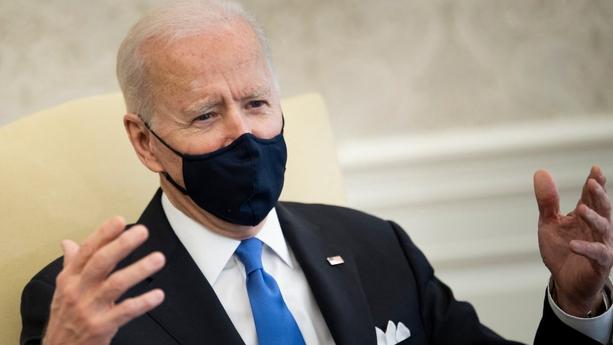 US President Joe Biden speaks to the press before a meeting in the Oval Office with lawmakers in the White House March 3, 2021, in Washington, DC. (BRENDAN SMIALOWSKI / AFP)
US President Joe Biden speaks to the press before a meeting in the Oval Office with lawmakers in the White House March 3, 2021, in Washington, DC. (BRENDAN SMIALOWSKI / AFP)
WASHINGTON — The US House of Representatives on March 10 approved the final version of the US$1.9 trillion COVID-19 relief bill, sending it to President Joe Biden’s desk for his signature amid rising inflation worries.
The Democrats-controlled House approved the final relief bill by a vote of 220 to 211 almost along party lines. The Senate passed the bill in a 50-49 vote last week after making changes to the original version passed by the House.
The legislation, known as American Rescue Plan Act of 2021, includes a new round of up to US$1,400 of direct payments for most Americans, US$350 billion for state and local governments, as well as funding to directly combat the pandemic. It also extends an additional US$300 weekly federal unemployment benefit through September.
White House press secretary Jen Psaki said March 10 that Biden plans to sign the relief package into law on March 12.
“We are moving full speed ahead on the implementation of the bill, because we know the American people need help, and need it as soon as possible,” Psaki said at a White House press briefing.
It marks the sixth coronavirus-related legislation enacted by United States Congress since the pandemic began more than a year ago.
Democrats have touted the US$1.9-trillion measure as one of the most popular bills in decades, calling it a bold COVID-19 relief for people across the country, which would significantly cut poverty and boost recovery.
However, Republicans argue that it is too costly, accusing Democrats of abandoning bipartisanship to jam through liberal policies unrelated to the pandemic.
Wall Street and public-sector economists have revised up forecasts for US economic growth due to the massive relief package and the vaccine rollout.
The Organisation for Economic Cooperation and Development on March 9 predicted that the US economy would expand 6.5 percent in 2021, up from 3.2 percent estimated three months ago.
The US economy contracted 3.5 percent in 2020 as the pandemic depressed consumer spending and business investment, the largest annual decline of US gross domestic product since 1946.
Some renowned economists, including former US Treasury Secretary Larry Summers, have also warned that too much stimulus could lead to an overheating economy and inflationary pressures, with consequences for the value of the dollar and financial stability.
“I very much agree with Larry Summers’s view that the Biden budget stimulus package is excessively large and will cause the US economy to overheat,” Desmond Lachman, resident fellow at the American Enterprise Institute and a former official at the International Monetary Fund, told Xinhua.
Coming on top of the US$900-billion relief package approved by Congress in December, Biden’s US$1.9-trillion package means that the US economy would get fiscal stimulus of around 13 percent of US GDP this year, he said.
Since the start of the year, the yield on the benchmark 10-year US Treasury note has jumped from 0.9 percent to around 1.5 percent amid growing concern about inflation.
Meanwhile, the market’s inflationary expectation for the next five years has jumped to around 2.4 percent, a level above the Federal Reserve’s inflation target of 2 percent.
But Fed Chair Jerome Powell has played down concerns of an inflationary outbreak.


